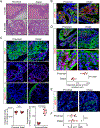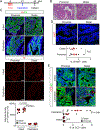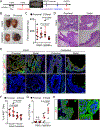Sox2 is necessary for androgen ablation-induced neuroendocrine differentiation from Pten null Sca-1+ prostate luminal cells
- PMID: 33110232
- PMCID: PMC7796948
- DOI: 10.1038/s41388-020-01526-2
Sox2 is necessary for androgen ablation-induced neuroendocrine differentiation from Pten null Sca-1+ prostate luminal cells
Abstract
Prostate adenocarcinoma undergoes neuroendocrine differentiation to acquire resistance toward antihormonal therapies. The underlying mechanisms have been investigated extensively, among which Sox2 has been shown to play a critical role. However, genetic evidence in mouse models for prostate cancer to support the crucial role of Sox2 is missing. The adult mouse prostate luminal cells contain both castration-resistant Sox2-expressing Sca-1+ cells and castration-responsive Sca-1- cells. We show that both types of the luminal cell are susceptible to oncogenic transformation induced by loss of function of the tumor suppressor Pten. The tumors derived from the Sca-1+ cells are castration resistant and are more inclined to develop castration-induced neuroendocrine differentiation. Genetic ablation of Sox2 suppresses neuroendocrine differentiation but does not impact the castration-resistant property. This study provides direct genetic evidence that Sox2 is necessary for androgen ablation-induced neuroendocrine differentiation of Pten null prostate adenocarcinoma, corroborates that the lineage status of the prostate cancer cells is a determinant for its propensity to exhibit lineage plasticity, and supports that the intrinsic features of cell-of-origin for prostate cancers can dictate their clinical behaviors.
Conflict of interest statement
Disclosure of Potential Conflicts of Interest
The authors declare no conflict of interest.
Figures






Similar articles
-
A rare castration-resistant progenitor cell population is highly enriched in Pten-null prostate tumours.J Pathol. 2017 Sep;243(1):51-64. doi: 10.1002/path.4924. Epub 2017 Jul 28. J Pathol. 2017. PMID: 28603917
-
The Role of Castration-Resistant Bmi1+Sox2+ Cells in Driving Recurrence in Prostate Cancer.J Natl Cancer Inst. 2019 Mar 1;111(3):311-321. doi: 10.1093/jnci/djy142. J Natl Cancer Inst. 2019. PMID: 30312426 Free PMC article.
-
The Sca-1+ and Sca-1- mouse prostatic luminal cell lineages are independently sustained.Stem Cells. 2020 Nov;38(11):1479-1491. doi: 10.1002/stem.3253. Epub 2020 Aug 8. Stem Cells. 2020. PMID: 32627901 Free PMC article.
-
Clinical and molecular features of treatment-related neuroendocrine prostate cancer.Int J Urol. 2018 Apr;25(4):345-351. doi: 10.1111/iju.13526. Epub 2018 Feb 3. Int J Urol. 2018. PMID: 29396873 Review.
-
Lineage plasticity in cancer: a shared pathway of therapeutic resistance.Nat Rev Clin Oncol. 2020 Jun;17(6):360-371. doi: 10.1038/s41571-020-0340-z. Epub 2020 Mar 9. Nat Rev Clin Oncol. 2020. PMID: 32152485 Free PMC article. Review.
Cited by
-
Ectopic JAK-STAT activation enables the transition to a stem-like and multilineage state conferring AR-targeted therapy resistance.Nat Cancer. 2022 Sep;3(9):1071-1087. doi: 10.1038/s43018-022-00431-9. Epub 2022 Sep 5. Nat Cancer. 2022. PMID: 36065066 Free PMC article.
-
Paracrine Wnt signaling is necessary for prostate epithelial proliferation.Prostate. 2022 Apr;82(5):517-530. doi: 10.1002/pros.24298. Epub 2022 Jan 11. Prostate. 2022. PMID: 35014711 Free PMC article.
-
The Role of Epigenetic Change in Therapy-Induced Neuroendocrine Prostate Cancer Lineage Plasticity.Front Endocrinol (Lausanne). 2022 Jul 14;13:926585. doi: 10.3389/fendo.2022.926585. eCollection 2022. Front Endocrinol (Lausanne). 2022. PMID: 35909568 Free PMC article. Review.
-
Stromal FOXF2 suppresses prostate cancer progression and metastasis by enhancing antitumor immunity.Nat Commun. 2022 Nov 11;13(1):6828. doi: 10.1038/s41467-022-34665-z. Nat Commun. 2022. PMID: 36369237 Free PMC article.
-
Understanding and targeting prostate cancer cell heterogeneity and plasticity.Semin Cancer Biol. 2022 Jul;82:68-93. doi: 10.1016/j.semcancer.2021.11.001. Epub 2021 Nov 26. Semin Cancer Biol. 2022. PMID: 34844845 Free PMC article. Review.
References
-
- Davies AH, Beltran H, Zoubeidi A. Cellular plasticity and the neuroendocrine phenotype in prostate cancer. Nature reviews Urology. 2018;15(5):271–86. Epub 2018/02/21. - PubMed
Publication types
MeSH terms
Substances
Grants and funding
LinkOut - more resources
Full Text Sources
Molecular Biology Databases
Research Materials

